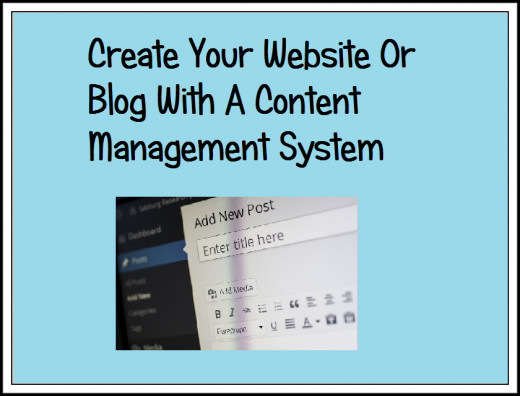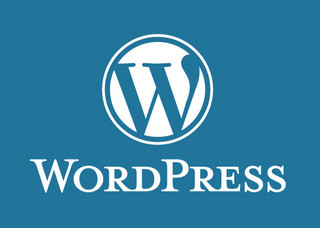How To Create a Website or Blog With a Content Management System

Overview
- Introduction
- What is a Content Management System?
- WordPress, the most popular Content Management System

Introduction
In my introductive hub about how to create your own website or blog I shared with you different ways of creating your own website or blog. The first way I shared with you was creating your website with HTML and CSS. I originally wanted to share HTML and CSS tutorials with you but then I thought this could be too complex and maybe boring for some of you.
So I decided to skip them and just go on with the Content Management System.


What is a Content Management System?
A Content Management System is a software for collectively creating, editing and organizing content on websites and other types of media. It manages the contents of a website. Via the web interface all contents can be written and edited.
Content and layout are separated
The contents, the structure and the layout are filed separately – this is a further characteristic of a Content Management System. If you change the style you don't need to create the complete website again. You can create menu entries in an online management system, the so called "backend", activate and deactivate them with few mouse clicks. The changes can be seen online immediately.
Intuitive interface
You work with a graphical interface when you create texts. It's easy to write and format your texts because the interface is like the one you already know from word processing programs. You don't need any HTML knowledge.
Contents are stored in data bases
The contents of a web presence are stored in data bases. Thus, an output in different formats is possible. Besides the normal website display, a specialized format for printing, or a version for smartphones may be possible.
Secondary use of contents
Contents can be reused via a Content Management System. The system selects the news from external websites and places them where you want them to have. Your website will have additional topicality.
Time-dependent contents
Sometimes it is necessary to read contents online at a certain time. With a Content Management System you can publish content at a certain date.
The system can be extended with so called modules or plug-ins
So called modules or plug-ins allow to extend the existing system without changing the core system. With little technical knowledge your site can be functionally complemented anytime.
Assign different roles to contributers
Creating and maintaining a website within a company requires different contributers like authors, editors, graphic designers or webmasters. Due to the Content Management System you may assign different roles to your contributers.


WordPress, the Most Popular Content Management System
WordPress is a Web Software with which you can create modern Internet presences, websites, blogs and online shops. WordPress is free software so you don't have to pay for it and you can also contribute to its quality anytime if you want.
It has many great and important functions:
User-friendliness
It's very easy and comfortable to install WordPress and work with it. It's not necessary to know PHP, HTML, Javascript or CSS but they help to customize your blog to your own needs.
Easy installation and upgrades
The installation of WordPress and the upgrades of previous versions are very easy and very well documented.
Post preview
Posts can be viewed during creation in the design of the blog. In the preview the posts are exactly shown as they look after publishing.
The WYSIWYG Editor
Wordpress has a post editor with which you can already see while writing how the text will look like without decoding tags. Furthermore, you can enlarge the input area just by dragging the corners to make it bigger. As an administrator you can decide if you want to use the editor or turn it off.
Uploading images and files
Images or files can be easily uploaded while you are creating your article. Afterwards, the images can be inserted into the post via drag-and-drop. You can also choose an image from already uploaded images.
Several authors
With one WordPress installation several authors can contribute to. Users get certain roles. These roles have authorities like "Edit posts" and "Activate Plug-ins", for example, with which certain actions are allowed. A custom assignment of permissions is realizable.
Comments
Visitors of your blog can create a comment to your post. Before publishing a post you can turn on or off the comment function.
Link manager
Via the clear administration interface links can be easily added, managed and renewed.
Password protected articles
You can assign an individual password to each article.
Spam protection
With WordPress you directly get the Akismet Plug-in against comment spam. Those who don't want to use that Plug-in can block comment spam with the help of a "Blacklist". Of course, the comment function can be limited to registered members and the like in the blog settings.
Communications service
WordPress supports both Trackback and Pingback and will also support future services of this kind as soon as they are developed.
Free software is not a question of the price but of attitude. The programmer grants the user very extensive rights. In contrary to proprietary software which has a license that completely forbids copying you are explicitly allowed to give a copy of the software to someone else. You are explicitly allowed to share the improvements you made to the software with the community.
The free software is not a "freebie" but it gives you the freedom
- to use the software for any desired purpose
- to study the functions of the software and to customize it to your own needs
- to give away copies of the software
- to improve the software and to publish these improvements
As a user of the software you particularly get access to its source code because it is the precondition for studying, customizing and improving the software. Free software is therefore also called Open Source software.

It is even easier!
With most of the big Webhosting Providers like Hostgator and Bluehost you can install WordPress even more quickly and easily, for example, with the Fantastico script.
How To Install WordPress Quickly and Easily
With most of the installations WordPress is that uncomplicated that the process from download to blogging only takes 5 minutes or less. Before you start, check if the server where WordPress should run has all the requirements.
These are the steps for installing WordPress:
- Unpack the package which you have just downloaded.
- Open the file wp-config-sample.php with a simple text editor (Notepad, Windows Editor, but not Word or OpenOffice Writer) and insert the necessary data base information and the security key.
- Save this file under the new name wp-config.php.
- Transfer all the files to your server.
- Start the installation by visiting the site install.php in your browser. You can find it relatively to the files which you have uploaded, in the wp-admin file. As I don't know the path to your file you have to adjust the following example accordingly:
- http://www.example.org/the_file_in_which_ your_WordPress_is/wp-admin/install.php
- Memorize the password which you enter during the installation.
That's it!

More WordPress Features
WordPress is a database-based application. All text contents like posts and comments are stored in the data base and all uploaded media like images and videos are filed on the web space. Contents are separated from the design. This means that the design can be changed any time without having to change the contents.
At WordPress the design templates are called themes and by now there are thousands of free and countless commercial themes available. In the official theme directory there is a great choice of free themes. In the WordPress administration area themes from the directory can be installed and activated with few clicks.
With a little bit of training each theme can be individualized. To create or change a theme WordPress has it is own system – you don't have to be a PHP programmer although basic knowledge of PHP, CSS and Javascript would be an advantage.
With plug-ins you can extend the range of functions of WordPress arbitrarily. A plug-in against spam, a contact form plug-in, a SEO plug-in … plug-ins leave nothing to be desired.
Plug-ins can be directly installed through the user interface of WordPress or be added manually.
E-Commerce with WordPress is booming. By now, there are numerous extensions to run a professional online shop. With a range of plug-ins it is possible to connect the preferences of WordPress productively with the requirements of an online shop.
Blogging with WordPress is great and the following apps make it even easier. If you want to publish on mobile devices there is a suitable app for your smartphone or tablet PC.
WordPress for iOS
WordPress for iOS is an app with which you can write posts, upload photos, edit and manage pages and moderate comments with your iPhone, iPad or iPod touch.
WordPress for Android
Write new posts for your WordPress blog, edit contents and moderate comments with integrated notification, everything on your Android device.
WordPress for BlackBerry
Publish posts, manage pages and moderate comments, upload images and much more with the app for your BlackBerry.
WordPress for Windows Phone 7
WordPress for Windows Phone 7 makes it easy to manage a blog or website on the go. Writing and editing of articles and pages is super easy. You can easily moderate comments and check stats.
WordPress for Nokia
WordPress for Nokia makes it possible for you to edit your blog contents and new posts and to create pages. Manage comments and much more directly from your Nokia smartphone.
WordPress for WebOS
WordPress for webOS is a new way of blogging on the go. It uses sliding panel applications with which you can manage the contents in your blog intuitively and productively. The visual editor helps you to format your posts.
What about you?
Do you have a WordPress blog?
Learn more about creating a website or blog
- How To Create a Website or Blog - Introduction
Do you want to create your own website or blog? It's not as difficult as it was in the past. Learn about the steps you need to go through and about different tools to create your website or blog.

About the author
Hi, I'm Janet. I'm happily married, mother of two amazing children, working as an educator.
I love writing, reading, creating websites and blogs, crafting, Social Media and Internet Marketing.
To know more about me, you can visit my website Writing Webworking Mom.
© 2014 Janet Giessl










